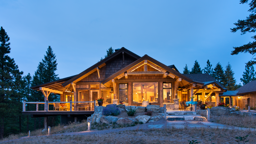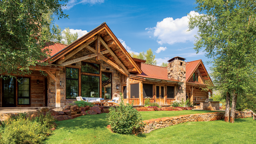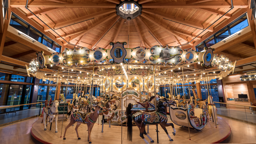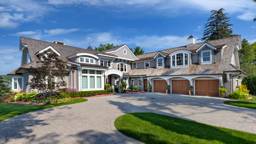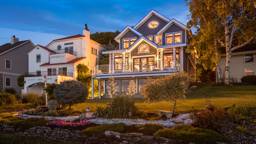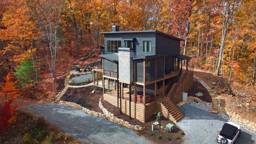Timber-frame and log houses often conjure notions of remote rustic outposts located in solitary surroundings of open grasslands or mature woodlands. It’s not very often one immediately thinks upscale suburb. So when developer Fred Austin approached MossCreek to create a timber-framed log home on less than an acre site in the densely populated Pronghorn development — a gated golf course community just outside Bend, Oregon — the principle of the firm, Allen Halcomb, was intrigued.
Bend, on the eastern side of the Cascade Mountains, has an arid desert climate — warm sunny days and cool nights — making it an ideal environment for a second home. Halcomb had designed Austin’s primary residence in Bend, and he liked the experience so much he wanted to work with Halcomb to design a spec house in this development.
“One of the greatest challenges in designing a house in this type of community is that neighbors sit close — in this case, 30 feet on both sides — so you want to be cognizant of privacy when it comes to the placement of rooms, windows and doors,” says Halcomb. “You also want to maintain that lodge retreat atmosphere within the house.”
To play up that feeling of seclusion, Halcomb chose to orient the living spaces to the back of the house, which faces east and offers expansive views of the golf course. Halcomb designed the public, or street, side of the house to create drama and a high-desert architectural theme.
High-Desert Design.
MossCreek approached the house’s front facade with a nod toward Tuscan villas, creating a vertical “bell tower” as a focal point. The home’s staircase is reserved for this space. “Stairs can often be a visual blocker,” says Halcomb. “This treatment eliminates the stairs from the main open floor plan.”
The house is otherwise built, essentially, with horizontal massing, which follows more traditional designs in the area. Except for the fanciful tower and stucco walls, the home speaks to its Oregon surroundings: locally quarried stone, massive 20-inch western red cedar logs, 8-inch wane board on the main level, and vertical board and batten on the upper level. “We drew from the regional vernacular of log houses,” says Halcomb.
“The house construction is really a hybrid of the traditional timber frame — the roof trusses and rafters fit into pockets in a stud wall framing,” he continues. “Combining conventional framing and timber framing makes the house more cost effective.”
Open Interiors.
Halcomb created more drama in the design, rivaling an evening at La Scala. The entrance is a log gable-covered porch with stacked stone tapered pillars. Handcrafted double doors open into a foyer and the great room beyond, which offers uninterrupted views through a wall of floor-to-ceiling glass sliders out to green swaths of grass and native juniper and ponderosa trees. “The floor plan is open, making it perfect for entertaining,” says Fred.
Halcomb introduces visual divides in the open floor plan — which includes the great room, kitchen and dining room — through structural elements. The ceiling treatment changes between the spaces. For instance, the dining room, although open to the kitchen, has a vaulted ceiling, as opposed to the flat ceiling in the living room and kitchen. The exposed log rafters found throughout create cohesion in the design. A massasa teak bar imported from South Africa becomes the visual divide between the kitchen and great room.
Another design divide is a jumped stacked stone wall with a see-through fireplace that separates a parlor from the great room. The stone echoes the exterior stone pillars. The great room mantel pays homage to this region, with its shelf made of juniper, a tree indigenous to Oregon. MossCreek walled the dining area in glass windows on three sides to further the experience of wide, open spaces. The window trim in the dining room is oversized to create balance with the massive log beams.
The tile floors found throughout these spaces tie the aesthetic together and also help cool the spaces during hot days, explains Halcomb. Slate flooring and countertops in the wine room just off the kitchen also aid in keeping vintages stored at the appropriate temperature. The only private spaces on the main level are a guest bedroom and media room. The other private rooms — the master bedroom and another guest room — are found on the upper level.
Rustic Exteriors.
Halcomb also designed the exterior spaces with entertaining in mind. Off the kitchen, a stone terrace offers ample space for outdoor grilling. Off the great room is a dining patio with a deep roof overhang to protect it from the hot sun, and the media room opens onto a porch complete with a hot tub. A low stone wall hides the hot tub from the golf course, offering total privacy.
While the home’s public front plays on its Italian influence, the back of the house, which is viewed from the golf course, plays up its rustic lodge appeal — all porch posts, roof rafters, trusses and support beams are log, while an upper-level balcony railing is a tenon construction. The getaway lodge offers luxury wrapped in a design fitting for its Western setting.
Home Details
Square footage: 4,000
Designer: MossCreek Designs












